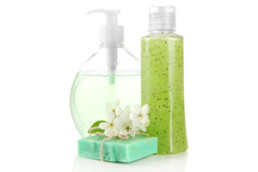Color Control in Soap
Manufactures add scents to soap to make using it a pleasant experience; visually it makes sense to have the color of the soap to reflect the scent to enhance the overall effect. As an example, “Lavender” hand soap will probably be a light purple in color. “Kitchen Lemon” is likely to be yellow, etc. In reality, neither the scent nor color of the soap will play a role in its efficiency to kill bacteria and viral contaminants; however, inconsistent color on store shelves will have an impact on that perception. If one quarter of the lavender soap was not as “purple” as the other (lacking of chroma), it is possible consumers would think of this as either weak or old, and would gravitate to the more brilliant colored soaps.
A properly maintained spectrophotomer allows manufacturers to maintain consistent colors throughout their processes from development, to production, to consumer. For opaque material, we recommend a reflection spectrophotometer (colored light reflecting off the material). For transparent, or translucent, a spectrophotometer with transmission measurement (colored light transmitting through the substance) is best. A spectrophotometer capable of measuring both reflection and transmission, like the CM-5, would be ideal for companies making opaque and translucent/transparent soaps.
By developing a standard color for each variant, manufacturers can subjectively (visually) assure acceptability with use of a light booth, which offers standardized viewing conditions, and can replicate how the soap will look in the store as well as the home. In conjunction with that method, the use of a spectrophotometer (like the CM-5 mentioned above) will allow for objective measurements (via instrumentation) that allows quantitative data for any samples for color quality control and communication. By using this measured information, be it spectral data or tristimulus data such as CIEL*a*b*, any non-acceptable deviation from the standard can be quickly and easily communicated to the proper personnel, to apply the proper correction. Catching incorrectly colored product early in the production cycle saves manufacturers time and money, and drastically reduces rework and waste.
With a proper color quality control process in place, manufactures can assure customers that their products will look as good as they work.










